Retrieving Information from Memory
In the last section, we focused on how to encode information into long-term memory. In this section, we will examine how we retrieve encoded information. First, we will consider the various ways that retrieval is measured. This will be followed by a discussion of forgetting, the failure to retrieve. Here we will discuss the major theories of why our memories fail us. Then, we will examine the reconstructive nature of the retrieval process by considering the role of schemas, source misattribution, and the misinformation effect. Finally, we will discuss the problem of “false” memories.
How to Measure Retrieval
The three main methods for measuring our ability to retrieve information from long-term memory are recall, recognition, and relearning. Recall is a measure of retrieval that requires the reproduction of the information with essentially no retrieval cues. Common recall measures would be short-answer and essay test questions. Recognition is a measure of retrieval that only requires the identification of the information in the presence of retrieval cues. In a recognition test you do not have to reproduce the information, you only have to identify it. Multiple-choice and matching test questions are examples of recognition test questions. Usually such questions are easier because retrieval cues (the answers themselves) are present to help you remember the information. The third method, relearning, is sometimes called the savings method because it is a measure of the amount of time saved when learning information for the second time. The most relevant example of relearning for students is studying for a comprehensive final examination in a course. You must relearn the material. It will take you less time to relearn it, but how much less depends upon how well you learned it the first time.

Hermann Ebbinghaus conducted the first experimental studies on human memory over a hundred years ago in Germany using the relearning method (Ebbinghaus, 1885/1964). His stimulus materials were lists of nonsense syllables, groupings of three letters (consonant-vowel-consonant such as BAV) that are not words or acronyms. He used meaningless nonsense syllables because he wanted to study pure memory for the list items. His familiarity with and knowledge of words and acronyms would have affected his ability to learn and remember the lists. His experimental procedure was very straightforward. He would study a list of nonsense syllables until he could correctly recite the complete list without any hesitations. He then put the list aside and waited some period of time (from 20 minutes up to 31 days) and then relearned the list to the same criterion (one complete recitation without any hesitations).
To get a measure of relearning, Ebbinghaus computed what he called a savings score—the reduction in the number of trials it took him to reach criterion. For example, if it took him 10 trials to learn a list initially and only 5 to relearn it, he saved 50 percent (5 vs. 10 trials). He used many different lists of nonsense syllables and many different retention intervals (the different amounts of time between initial learning and relearning). The results were like those shown in Figure 5.8. The forgetting curve in this figure shows that the greatest amount of forgetting occurs rather quickly and then tapers off. In Ebbinghaus’s case, after about 2 days, little more forgetting occurred. This type of forgetting curve for long-term memory has been obtained over and over again in memory research (Bahrick, 1984). What causes this forgetting? Let’s consider some possible explanations.
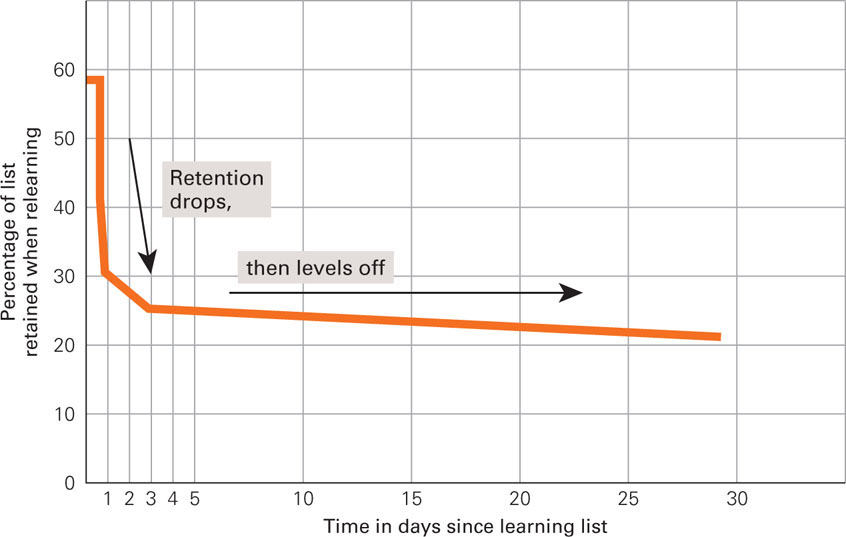
 Figure 5.8 Forgetting Curve for Long-Term Memory The course of long-term forgetting usually takes on the shape of this figure—a rapid steep decrease that then levels off. In Ebbinghaus’s memory research with nonsense syllables, the amount of time he saved relearning the material decreased dramatically for the first 2 days following initial learning and then leveled off after that.
Figure 5.8 Forgetting Curve for Long-Term Memory The course of long-term forgetting usually takes on the shape of this figure—a rapid steep decrease that then levels off. In Ebbinghaus’s memory research with nonsense syllables, the amount of time he saved relearning the material decreased dramatically for the first 2 days following initial learning and then leveled off after that.Why We Forget
There is no question that we forget. Our memories clearly fail us. This is especially problematic for exams. Haven’t we all taken an exam and forgotten some information and then retrieved it after the exam was over? To understand forgetting, we must confront two questions. First, why do we forget? Second, do we really ever truly forget or do we just fail to retrieve information at a particular point in time? To answer these questions, we’ll take a look at four theories of forgetting—encoding failure theory, storage decay theory, interference theory, and cue-dependent theory.
Encoding failure theory states that sometimes forgetting is not really forgetting but rather encoding failure (sometimes called pseudoforgetting). The information in question never entered long-term memory. We can’t forget information that never entered long-term memory (that we never encoded into long-term memory). This would be like trying to locate a particular book in a library when the library never purchased it. For a good example of encoding failure, take the common penny. How well do you remember its features? Take a few minutes and try to draw the front and back of a penny. If you’re like the participants in Nickerson and Adams’s (1979) study, you’ll find this difficult to do. There are eight critical features on a penny, and Nickerson and Adams found the median number recalled and located correctly to be just three. As a second exercise, consider Figure 5.9. Which one of these pennies is the real penny? Nickerson and Adams found that most Americans do not know. Why? They probably never encoded the details of the penny, so just as they cannot draw a penny correctly, they cannot pick out the real one from fake ones. If we do not encode information into long-term memory, we obviously will not be able to remember it.
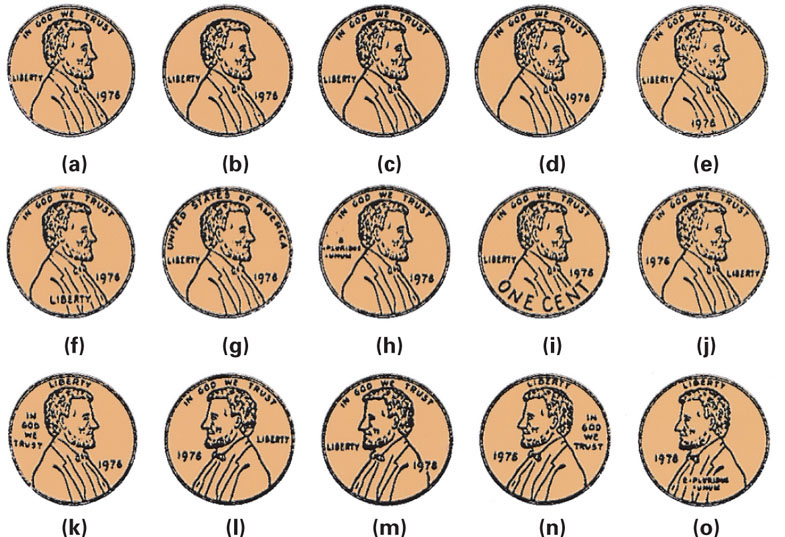
 Figure 5.9 An Example of Encoding Failure Can you identify the real penny? Most Americans cannot. Why? The answer is likely encoding failure. Most of us are not that interested in coins and have never bothered to encode the exact features of a penny into long-term memory, so we have difficulty in choosing the real penny. This may be referred to as forgetting, but it is more appropriately called encoding failure. You can’t really forget something that you did not put into long-term memory. The first penny (a) is the real penny.
Figure 5.9 An Example of Encoding Failure Can you identify the real penny? Most Americans cannot. Why? The answer is likely encoding failure. Most of us are not that interested in coins and have never bothered to encode the exact features of a penny into long-term memory, so we have difficulty in choosing the real penny. This may be referred to as forgetting, but it is more appropriately called encoding failure. You can’t really forget something that you did not put into long-term memory. The first penny (a) is the real penny.The other three theories of forgetting deal with information that was encoded into long-term memory, but that we cannot retrieve. The storage decay theory suggests that forgetting occurs because of a problem in the storage of the information. The storage decay theory assumes that the biological representation of the memory gradually decays over time and that periodic usage of the information will help to maintain it in storage. This latter assumption reflects the “use it or lose it” principle. This theory proposes that we forget because the information is no longer available in long-term memory. We forget because we cannot possibly remember it. The memory trace has decayed away. This would be like trying to get a particular book from a library, but finding that its pages had rotted away.
The other two theories of forgetting propose that there are retrieval problems and not a problem with storage. Both assume that the forgotten information is still available in long-term memory, but cannot be retrieved. Each of the theories proposes a different reason for why the information cannot be retrieved. Interference theory proposes that other information interferes and makes the forgotten information inaccessible. In our library book example, this would be comparable to boxes of books blocking access to the location where the book is located. This theory proposes two types of such interference: (1) proactive interference—the disruptive effect of prior learning on the retrieval of new information, and (2) retroactive interference—the disruptive effect of new learning on the retrieval of old information. To help you understand the difference between these two types of interference, remember that proactive is forward acting and retroactive is backward acting interference. Let’s consider a couple of examples. Think about changing phone numbers after having a particular number for many years. When asked for your phone number, remembering the old one interferes with retrieving the new one. This would be proactive interference. The disruptive effect is from prior learning (your old phone number). For an example of retroactive interference, think about being at a party with many people you do not know. You meet someone that you want to talk to later, but after meeting her, you are introduced to several other people. Now you cannot remember her name. The names of the people that you met after her are interfering with your retrieval of her name. This is retroactive interference because it is a case of the disruptive effect of new learning on the retrieval of old information. An additional example of each type of interference is given in Figure 5.10.
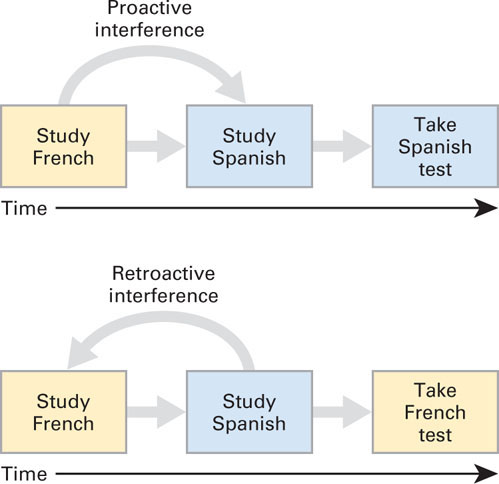
 Figure 5.10 Proactive and Retroactive Interference In the proactive interference example, prior learning (French) disrupts memory for newly learned information (Spanish). In the retroactive interference example, new learning (Spanish) disrupts memory for information learned earlier (French).
Figure 5.10 Proactive and Retroactive Interference In the proactive interference example, prior learning (French) disrupts memory for newly learned information (Spanish). In the retroactive interference example, new learning (Spanish) disrupts memory for information learned earlier (French).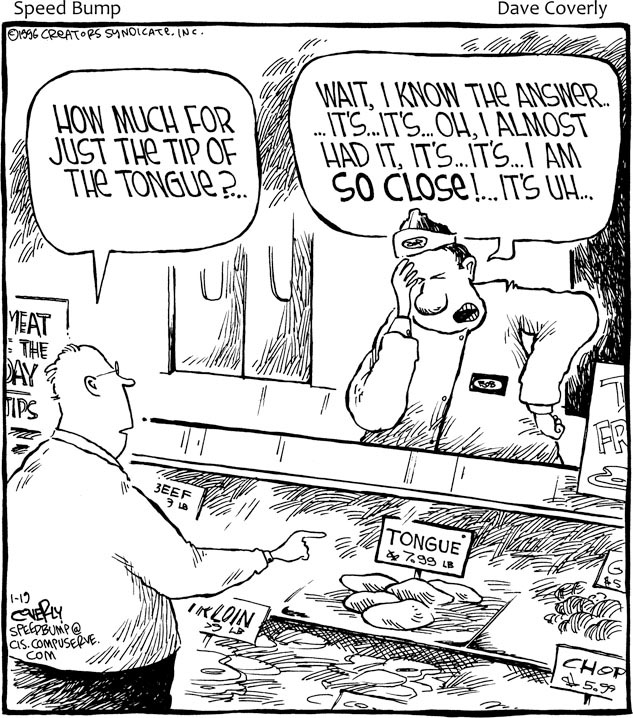
Cue-dependent theory also assumes that forgetting stems from not gaining access to the desired information (Tulving, 1974). According to cue-dependent theory, we forget because the cues necessary for retrieval are not available. The information is available, but we cannot access it because we cannot find it. This is like trying to find a particular book in a library without its call number and a map of the library stacks. We wouldn’t have the cues necessary to locate it, so it is likely we would not be able to do so. Successful retrieval is dependent upon the availability of the retrieval cues. An example of forgetting involving inaccessibility due to insufficient cues that all of us have experienced is the tip-of-the-tongue (TOT) phenomenon in which we can almost recall something, but the memory eludes us (Brown & McNeill, 1966). The phenomenon’s name comes from the colloquial saying, “It’s on the tip of my tongue.” You feel like you know the inaccessible information and are on the brink of retrieving it. Diary research indicates that college students experience roughly one or two TOT states per week, compared to two to four per week for elderly adults; middle-aged adults fall somewhere in between (Schacter, 2000). TOT experiences occur most often for names of people. You may remember what letter begins a person’s name, but you still cannot retrieve the name. You are confident that you know it, but you just don’t seem able to pull it out of your memory. Partial information about the name often helps to resolve the TOT state by providing cues that lead to successful recall.
So, there are many reasons why we forget. The four major theories are summarized in Table 5.2, but how can you apply this knowledge to enhance your learning? First, sometimes we forget because we do not encode the information into long-term memory. You should be especially wary of this reason when you are preparing for your class exams. You need to study thoroughly to avoid encoding failure on exams. Second, we may forget if information that is encoded and stored in long-term memory isn’t periodically recalled and refreshed. The information can fade away over time. Think about what you have learned in the various courses that you have taken so far in college. After a course is over, you may sometimes feel like you retained little of that information for very long. If you want to retain more of it for a longer period of time, you need to regularly recall and use it. Third, the information that we are trying to retrieve may still be there, but we forget because other information may interfere with our retrieval of it or we may not have the necessary retrieval cues available to find it. Both elaboration during encoding and overlearning will help to reduce these retrieval problems.
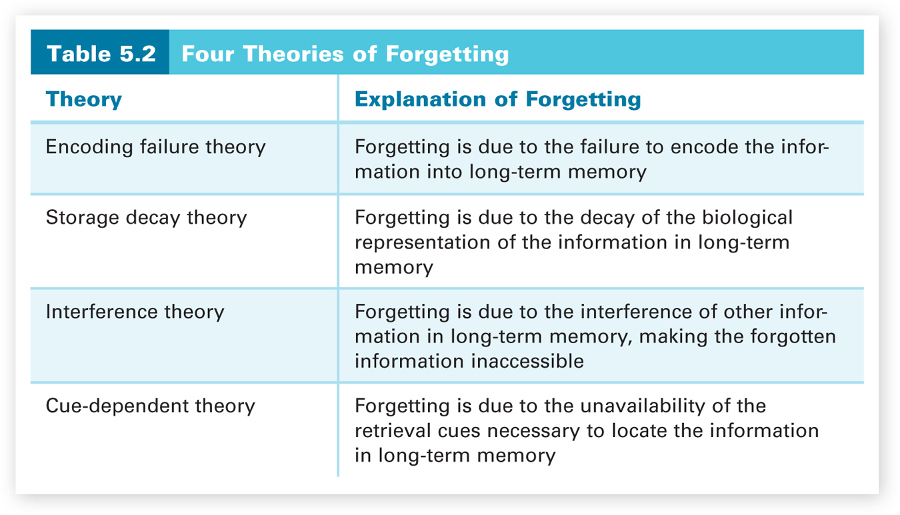
The next section concerns the information that we do retrieve. Is it accurate or is it distorted? The answer is that it is often distorted. How does this occur? It occurs because retrieval is reconstructive and not exact. Let’s take at look at the retrieval process to see how its reconstructive nature may distort our memories.
The Reconstructive Nature of Retrieval
The act of remembering is an act of reconstruction. Memory does not work like a tape recorder or a video recorder. Retrieval is not like playback. Our memories are far from exact replicas of past events. If you read a newspaper this morning, do you remember the stories that you read in the paper word for word? We usually encode the gist or main theme of the story along with some of the story’s highlights. Then, when we retrieve the information from our memory, we reconstruct a memory of the story using the theme and the highlights.
Our retrieval reconstruction is guided by what are called schemas—frameworks for our knowledge about people, objects, events, and actions. These schemas allow us to organize our world. For example, what happens when you enter a dentist’s office or what happens when you go to a restaurant to eat? You have schemas in your memory for these events. The schemas tell us what normally happens. For example, consider the schema for eating out in a restaurant (Schank & Abelson, 1977). First, a host or hostess seats you and gives you a menu. Then the waitperson gets your drink order, brings your drinks, and then takes your meal order. Your food arrives, you eat it, the waitperson brings the bill. You pay it, leave a tip, and go. These schemas allow us to encode and retrieve information about the world in a more organized, efficient manner.
The first experimental work on schemas and their effects on memory was conducted by Sir Frederick Bartlett in the first half of the twentieth century (Bartlett, 1932). Bartlett had his participants study some stories that were rather unusual. He then tested their memory for these stories at varying time intervals. When the participants recalled the stories, they made them more consistent with their own schemas about the world. For example, one story did not say anyone was wounded in the battle described, but participants recalled that many men were wounded, fitting their schemas for battles. Unusual details were normalized. For example, participants recalled incorrectly that the men in another story were fishing rather than hunting seals. In addition, the stories were greatly shortened in length when recalled. Strangely, the participants did not even realize that they were changing many of the details of the stories. In fact, the parts that they changed were those that they were most confident about remembering.
Bartlett’s participants had reconstructed the stories using their schemas and did not even realize it. The main point to remember is that they distorted the stories in line with their schemas. Why? Schemas allow us to encode and retrieve information more efficiently. It would be impossible to encode and retrieve the exact details of every event in our lives. That’s why we need organizing schemas to guide us in this task, even though they do not provide an exact copy of what happened. This seems a small cost given the benefits provided by organizing memory in terms of schemas.
Memory can be further distorted in reconstruction by source misattribution and the misinformation effect. Source misattribution occurs when we do not remember the true source of a memory and attribute the memory to the wrong source. Maybe you dream something and then later misremember that it actually happened. You misattribute the source to actual occurrence rather than occurrence in a dream. Source information for memories is not very good. You need to beware of this when writing papers. You may unintentionally use another person’s ideas and think they are yours. You have forgotten their source. Even if source misattribution is unintentional, it is still plagiarism.
A famous case of source misattribution involved noted developmental psychologist Jean Piaget (Loftus & Ketcham, 1991). For much of his life, Piaget believed that when he was a child, his nursemaid had thwarted an attempt to kidnap him. He remembered the attempt, even remembered the details of the event. When the nursemaid finally admitted to making up the story, Piaget couldn’t believe it. He had reconstructed the event from the many times the nursemaid recounted the incident and misattributed the source to actual occurrence. This is like thinking that something we dreamed really occurred. The source of the memory is misattributed. Source misattribution results in what is called a false memory an inaccurate memory that feels as real as an accurate memory. False memories can also be the result of imagination and observation inflation and the misinformation effect.
Imagination inflation is increased confidence in a false memory of an event caused by repeatedly imagining the event. For example, imagining performing an action often induces a false memory of having actually performed it (Garry, Manning, Loftus, & Sherman, 1996; Goff & Roediger, 1998). Repeated imagining inflates the confidence the person has that he actually performed the action, the imagination inflation effect. What might cause this disconcerting memory failure? Several factors likely contribute to the formation of these false memories. For example, actually perceiving something and imagining it activate the same brain areas, leading to similar neural events that when tested might cause confusion as to whether the event was imagined or real (Gonsalves et al., 2004). Secondly, repeatedly imagining an event makes it seem increasingly familiar. This sense of familiarity can then be misinterpreted as evidence that the event actually occurred (Sharman, Garry, & Beuke, 2004). Lastly, the more vividly we are able to imagine events, the more likely it is that the imagined events feel like real events (Loftus, 2001; Thomas, Bulevich, & Loftus, 2003).
There is now evidence for a similar false memory effect in which a false memory of self-performance of an action is induced by merely observing another person’s actions (Lindner, Echterhoff, Davidson, & Brand, 2010). It has been named the observation inflation effect because of its similarity to the imagination inflation effect. What could account for this effect? The mirror neuron systems that we discussed in Chapter 4 may be involved. Research on mirroring suggests that observation of another person’s action may trigger a covert simulation of the action and thus activate motor representations similar to those produced during actual self-performance of the action (Iacoboni, 2009b). Other evidence suggests that the neural correlates for such mirrored motor representations are similar to those for self-performed actions (Senfor, Van Petten, & Kutas, 2002). Thus, when a person is tested about actually performing the observed action, the mirrored action representations could erroneously be reactivated, leading to the observation inflation effect (Lindner et al., 2010).
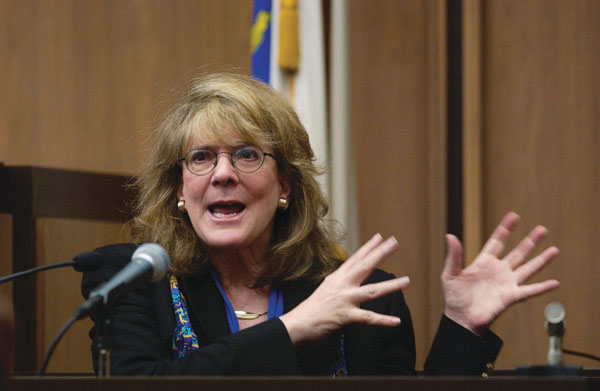
The misinformation effect occurs when a memory is distorted by subsequent exposure to misleading information (Loftus, 2005). Elizabeth Loftus and her colleagues have provided numerous demonstrations of the misinformation effect, involving thousands of subjects, over the past four decades (Frenda, Nichols, & Loftus, 2011). These studies usually involve witnessing an event and then being tested for memory of the event but being given misleading information at the time of the test. Let’s consider an example. Loftus and John Palmer (1974) showed participants a film of a traffic accident and then later tested their memory for the accident. The test included misleading information for some of the participants. For example, some participants were asked, “How fast were the cars going when they smashed into each other?” and others were asked, “How fast were the cars going when they hit each other?” Participants who were asked the question with the word “smashed” estimated the speed to be much higher than those who were asked the question with the word “hit.” In addition, when brought back a week later, those participants who had been questioned with the word “smashed” more often thought that they had seen broken glass in the accident when in fact there was none. The key theme of this line of research is that our memories for events are distorted by exposure to misinformation. The resulting false memories seem like real memories.

False memories have important implications for use of eyewitness testimony in criminal cases and for the controversy over memories of childhood sexual abuse that have supposedly been repressed but then are “recovered” in adulthood. The Loftus and Palmer research example shows us that eyewitness testimony is subject to error and manipulation by misleading information. Between 1989 and 2007, for example, 201 prisoners in the United States were freed because of DNA evidence; and 77 percent of these prisoners had been mistakenly identified by eyewitnesses (Hallinan, 2009). Many of these overturned cases rested on the testimony of two or more mistaken eyewitnesses. Eyewitnesses not only often misidentify innocent people as criminals but they also often do so with the utmost confidence, and jurors tend to heavily weigh an eyewitness’s confidence when judging their believability.
Clearly, certain types of interrogation, including the way questions are worded, could lead to false memories. With respect to the repressed memory controversy, many memory researchers are skeptical and think that these “recovered” memories may describe events that never occurred (like the kidnapping attempt on Piaget as a child). Instead, they may be false memories that have been constructed and may even have been inadvertently implanted by therapists during treatment sessions. In fact, researchers have demonstrated that such implanting is possible (Loftus, Coan, & Pickrell, 1996; Loftus & Ketchum, 1994). We must remember, however, that demonstrating the possibility of an event does not demonstrate that it actually happened. So, are all memories of childhood sexual abuse false? Absolutely not. Sexual abuse of all kinds is unfortunately all too real. The important point for us is that the research on false memory has provided empirical evidence to support an alternative explanation to the claims for recovered memories, and this will help to sort out the true cases from the false.
Section Summary
In this section, we considered the three ways to measure retrieval—recall, recognition, and relearning. In recall, the information has to be reproduced, but in recognition it only has to be identified. In relearning, the time one saves in relearning information is the measure of memory. For all three retrieval measures, forgetting from long-term memory levels off after a rapid initial burst of forgetting.
There are four major theories that address the question of why we forget. Encoding failure theory assumes that the information is never encoded into long-term memory, so it is not there to be retrieved. The storage decay theory assumes that the information is encoded but that it decays during storage so that it is no longer available to be retrieved. The other two theories assume that the information is still available in long-term memory, but cannot be accessed. Interference theory assumes that the retrieval failure is due to other information blocking our retrieval. This interfering information could be older information interfering with the retrieval of new information (proactive interference) or new information interfering with the retrieval of older information (retroactive interference). The other theory, cue-dependent theory, assumes that the cues necessary to retrieve the information are not available, meaning that the information cannot be located in long-term memory.
Memory is a reconstructive process guided by our schemas—organized frameworks of our knowledge about the world. The use of schemas along with source misattribution problems, imagination and observation inflation, and the misinformation effect can lead to false memories, inaccurate memories that feel as real as accurate memories. Such false memories create questions about the accuracy of eyewitness testimony and the validity of supposed repressed memories of childhood abuse.
Concept Check | 3
 Explain the difference between recall and recognition as methods to measure retrieval.
Explain the difference between recall and recognition as methods to measure retrieval.In recall, the information has to be reproduced. In recognition, the information only has to be identified.
 Explain how the four major theories of forgetting differ with respect to the availability versus accessibility of the forgotten information.
Explain how the four major theories of forgetting differ with respect to the availability versus accessibility of the forgotten information.Encoding failure theory and storage decay theory assume the forgotten information is not available in long-term memory. Both the interference and cue-dependent theories of forgetting assume it is still available but not accessible.
 Explain how schemas help to create false memories.
Explain how schemas help to create false memories.Schemas help to create false memories because in using them, we tend to replace the actual details of what happened with what typically happens in the event that the schema depicts. As Bartlett found in his schema research, this is especially true for unusual details. This means that schemas tend to normalize our memories and lead us to remember what usually happens and not exactly what did happen.
 Explain how source misattribution and the misinformation effect lead to false memories.
Explain how source misattribution and the misinformation effect lead to false memories.Source misattribution leads to false memories because we don’t really know the source of a memory. The event may never have occurred, but we think that it did because we misattributed the source of the memory. The misinformation effect leads to false memories through the effect of misleading information being given at the time of retrieval. We incorporate this misleading information for an event into our memory and thus create a false memory for it.